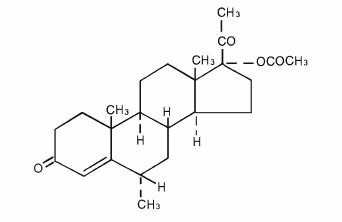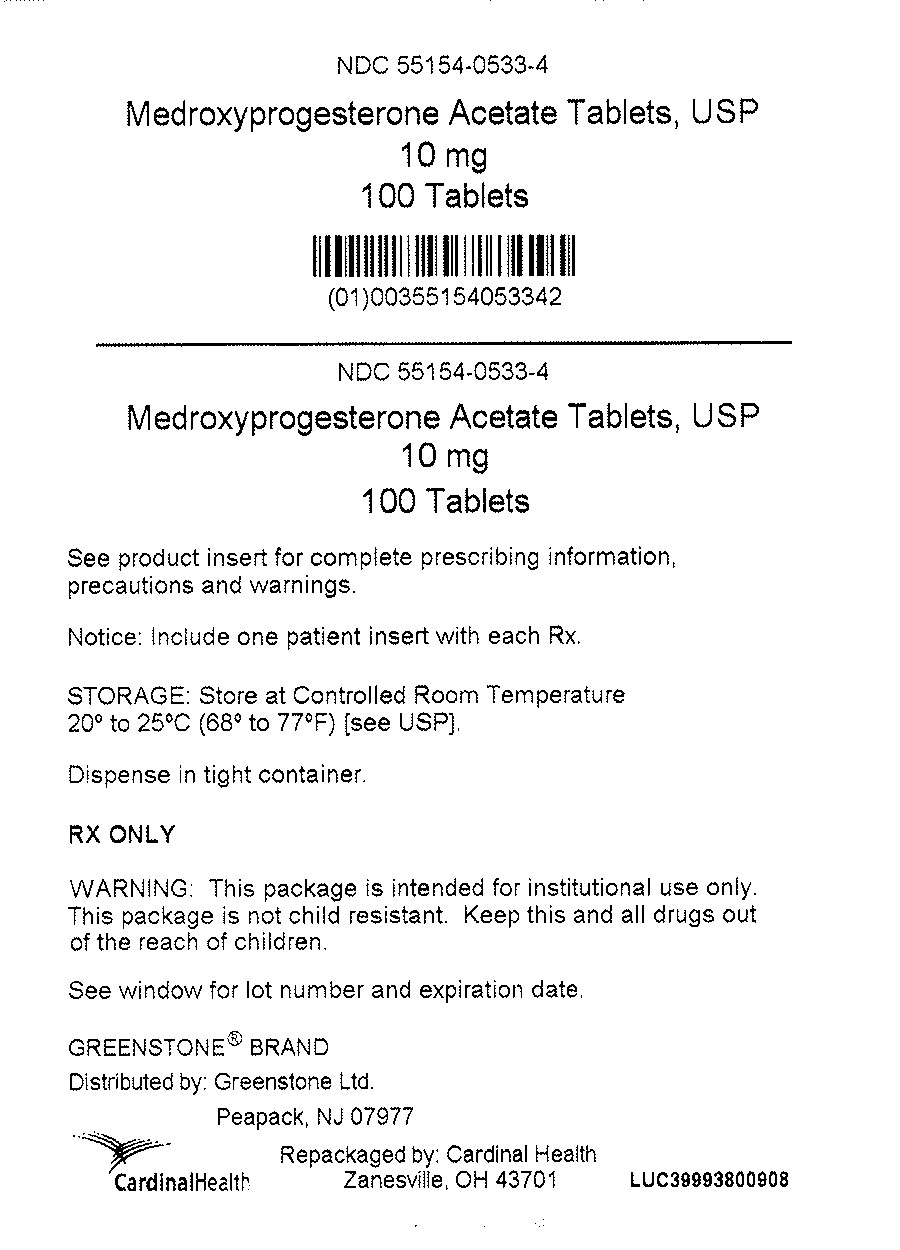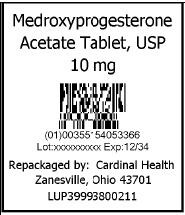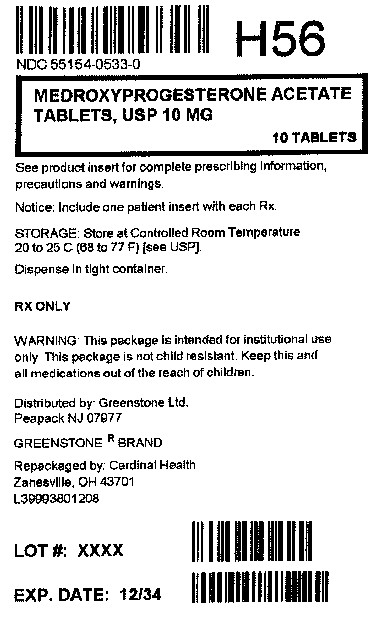medroxyprogesterone acetate
Medroxyprogesterone Acetate Tablets, USP
FULL PRESCRIBING INFORMATION: CONTENTS*
- MEDROXYPROGESTERONE ACETATE DESCRIPTION
- CLINICAL PHARMACOLOGY
- CLINICAL STUDIES
- MEDROXYPROGESTERONE ACETATE INDICATIONS AND USAGE
- MEDROXYPROGESTERONE ACETATE CONTRAINDICATIONS
- WARNINGS
- PRECAUTIONS
- MEDROXYPROGESTERONE ACETATE ADVERSE REACTIONS
- MEDROXYPROGESTERONE ACETATE DOSAGE AND ADMINISTRATION
- HOW SUPPLIED
- REFERENCES
- PATIENT INFORMATION
- PRINCIPAL DISPLAY PANEL - Carton
- PRINCIPAL DISPLAY PANEL - Pouch
- Principal Display Panel - Bag
FULL PRESCRIBING INFORMATION
MEDROXYPROGESTERONE ACETATE DESCRIPTION
Medroxyprogesterone acetate tablets contain medroxyprogesterone acetate, which is a derivative of progesterone. It is a white to off-white, odorless crystalline powder, stable in air, melting between 200 and 210°C. It is freely soluble in chloroform, soluble in acetone and in dioxane, sparingly soluble in alcohol and in methanol, slightly soluble in ether, and insoluble in water.
The chemical name for medroxyprogesterone acetate is Pregn-4-ene-3,20-dione, 17-(acetyloxy)-6-methyl-, (6α)-. The structural formula is:

Each tablet for oral administration contains 2.5 mg, 5 mg or 10 mg of medroxyprogesterone acetate.
Inactive ingredients: calcium stearate, corn starch, lactose, mineral oil, sorbic acid, sucrose, talc. The 2.5 mg tablet contains FD&C Yellow No. 6.
CLINICAL PHARMACOLOGY
Medroxyprogesterone acetate, administered orally or parenterally in the recommended doses to women with adequate endogenous estrogen, transforms proliferative into secretory endometrium. Androgenic and anabolic effects have been noted, but the drug is apparently devoid of significant estrogenic activity. While parenterally administered medroxyprogesterone acetate inhibits gonadotropin production, which in turn prevents follicular maturation and ovulation, available data indicate that this does not occur when the usually recommended oral dosage is given as single daily doses.
Pharmacokinetics
The pharmacokinetics of medroxyprogesterone acetate were determined in 20 postmenopausal women following a single-dose administration of eight medroxyprogesterone acetate tablets 2.5 mg or a single administration of two medroxyprogesterone acetate tablets 10 mg under fasting conditions. In another study, the steady-state pharmacokinetics of medroxyprogesterone acetate were determined under fasting conditions in 30 postmenopausal women following daily administration of one medroxyprogesterone acetate tablet 10 mg for 7 days. In both studies, medroxyprogesterone acetate was quantitated in serum using a validated gas chromatography-mass spectrometry (GC-MS) method. Estimates of the pharmacokinetic parameters of medroxyprogesterone acetate after single and multiple doses of medroxyprogesterone acetate tablets were highly variable and are summarized in Table 1.
| Tablet Strength | C max
(ng/mL) |
T max
(h) |
Auc 0–(∞)
(ng∙h/mL) |
t 1/2
(h) |
Vd/f (L) |
CL/f (mL/min) |
| Single Dose | ||||||
| 2 × 10 mg | 1.01 (0.599) | 2.65 (1.41) | 6.95 (3.39) | 12.1 (3.49) | 78024 (47220) |
64110 (42662) |
| 8 × 2.5 mg | 0.805 (0.413) | 2.22 (1.39) | 5.62 (2.79) | 11.6 (2.81) | 62748 (40146) |
74123 (35126) |
| Multiple Dose | ||||||
10 mg  |
0.71 (0.35) | 2.83 (1.83) | 6.01 (3.16) | 16.6 (15.0) | 40564 (38256) |
41963 (38402) |
Absorption: No specific investigation on the absolute bioavailability of medroxyprogesterone acetate in humans has been conducted. Medroxyprogesterone acetate is rapidly absorbed from the gastrointestinal tract, and maximum medroxyprogesterone acetate concentrations are obtained between 2 to 4 hours after oral administration.
Effect of Food: Administration of medroxyprogesterone acetate with food increases the bioavailability of medroxyprogesterone acetate. A 10-mg dose of medroxyprogesterone acetate, taken immediately before or after a meal, increased medroxyprogesterone acetate Cmax (50 to 70%) and AUC (18 to 33%). The half-life of medroxyprogesterone acetate was not changed with food.
Distribution: Medroxyprogesterone acetate is approximately 90% protein bound, primarily to albumin; no medroxyprogesterone acetate binding occurs with sex-hormone binding globulin. The unbound medroxyprogesterone acetate modulates pharmacologic responses.
Metabolism: Following oral dosing, medroxyprogesterone acetate is extensively metabolized in the liver via ring A and/or side-chain hydroxylation, with subsequent conjugation and elimination in the urine. At least 16 medroxyprogesterone acetate metabolites have been identified.
Excretion: Most medroxyprogesterone acetate metabolites are excreted in the urine as glucuronide conjugates with only minor amounts excreted as sulfates. Mean percent dose excreted in the 24-hour urine of patients with fatty liver as intact medroxyprogesterone acetate after a 10-mg or 100-mg dose was 7.3% and 6.4%, respectively.
Renal Insufficiency: The pharmacokinetics of medroxyprogesterone acetate in patients with varying degrees of renal insufficiency have not been investigated. The renal clearance of medroxyprogesterone acetate is negligible and a decrease in total body clearance is not expected in patients with renal insufficiency.
Hepatic Insufficiency: Medroxyprogesterone acetate is almost exclusively eliminated via hepatic metabolism. In 14 patients with advanced liver disease, medroxyprogesterone acetate disposition was significantly altered (reduced elimination). As such, medroxyprogesterone acetate is contraindicated in patients with severe hepatic disease (see CONTRAINDICATIONS). However, for patients with mild-moderate degree of hepatic impairment, a lower dose of medroxyprogesterone acetate or a less frequent administration should be considered.
No formal pharmacokinetic drug-drug interaction studies have been conducted with medroxyprogesterone acetate. However, published literature indicates that coadministration of conjugated estrogens with medroxyprogesterone acetate does not affect the pharmacokinetic profile of medroxyprogesterone acetate; similarly, medroxyprogesterone acetate does not affect the pharmacokinetic profile of the conjugated or unconjugated estrogens. Literature data also indicate that concomitant administration with aminoglutethimide would significantly reduce serum concentrations of medroxyprogesterone acetate, likely by increasing the clearance of the drug.
CLINICAL STUDIES
The use of unopposed estrogen therapy has been associated with an increased risk of endometrial hyperplasia, a possible precursor of endometrial carcinoma.1 The incidence of estrogen-associated endometrial hyperplasia and endometrial cancer was assessed in two large, long-term, randomized clinical trials. The histological results of the clinical studies indicate that the addition of medroxyprogesterone acetate to an estrogen replacement regimen for 12 to 14 days per cycle reduces the incidence of endometrial hyperplasia in women with intact uteri. The addition of a progestin to 0.625 mg conjugated estrogen has not been shown to interfere with the efficacy of 0.625 mg conjugated estrogen for its approved indications.1-3
A 3-year, double-blind, placebo-controlled study was conducted in which nonhysterectomized, postmenopausal women between the ages of 45 and 64 years were randomized to receive placebo, conjugated estrogen only, or conjugated estrogen plus cyclic medroxyprogesterone acetate. The treatment group receiving 10 mg medroxyprogesterone acetate plus 0.625 mg conjugated estrogens showed a significantly lower rate of hyperplasia in comparison to the group given 0.625 mg conjugated estrogens only. The 3-year histological results are summarized in Table 2.
| Histological Results | Placebo (n=119) |
CEE  (n=119) |
MPA (n=118) |
| Normal/No hyperplasia (%) | 116 (97) | 45 (38) | 112 (95) |
| Simple (cystic) hyperplasia (%) | 1 (1) | 33 (28) | 4 (3) |
| Complex (adenomatous) hyperplasia (%) | 1 (1) | 27 (22) | 2 (2) |
| Atypia (%) | 0 | 14 (12) | 0 |
| Adenocarcinoma (%) | 1 (1) | 0 | 0 |
In a second study, postmenopausal women between the ages of 45 and 65 years were enrolled in a 1-year, double-blind study. All patients received conjugated estrogen 0.625 mg every day of a 28-day cycle, and were randomized to receive cyclic medroxyprogesterone acetate 5 mg, cyclic medroxyprogesterone acetate 10 mg, or conjugated estrogen only. The treatment groups receiving medroxyprogesterone acetate 5 or 10 mg plus conjugated estrogens showed a significantly lower rate of hyperplasia in comparison to the group given conjugated estrogens only. The incidence of endometrial hyperplasia is shown in Table 3.
CEE  |
MPA   |
||
| (n=283) | MPA 5 mg (n=277) |
MPA 10 mg (n=272) |
|
| Cystic hyperplasia (%) | 55 (19) | 3 (1) | 0 |
| Adenomatous hyperplasia without atypia | 2 (1) | 0 | 0 |
MEDROXYPROGESTERONE ACETATE INDICATIONS AND USAGE
Medroxyprogesterone acetate tablets are indicated for secondary amenorrhea and for abnormal uterine bleeding due to hormonal imbalance in the absence of organic pathology, such as fibroids or uterine cancer. Medroxyprogesterone acetate tablets are also indicated to reduce the incidence of endometrial hyperplasia in nonhysterectomized postmenopausal women receiving 0.625 mg conjugated estrogen.
MEDROXYPROGESTERONE ACETATE CONTRAINDICATIONS
1. Thrombophlebitis, thromboembolic disorders, cerebral apoplexy or patients with a past history of these conditions.
2. Liver dysfunction or disease.
3. Known or suspected malignancy of breast or genital organs.
4. Undiagnosed vaginal bleeding.
5. Missed abortion.
6. As a diagnostic test for pregnancy.
7. Known sensitivity to medroxyprogesterone acetate tablets.
8. Known or suspected pregnancy.
WARNINGS
1. The physician should be alert to the earliest manifestations of thrombotic disorders (thrombophlebitis, cerebrovascular disorders, pulmonary embolism, and retinal thrombosis). Should any of these occur or be suspected, the drug should be discontinued immediately.
2. Beagle dogs treated with medroxyprogesterone acetate developed mammary nodules some of which were malignant. Although nodules occasionally appeared in control animals, they were intermittent in nature, whereas the nodules in the drug-treated animals were larger, more numerous, persistent, and there were some breast malignancies with metastases. Their significance with respect to humans has not been established.
3. Discontinue medication pending examination if there is sudden partial or complete loss of vision, or if there is a sudden onset of proptosis, diplopia or migraine. If examination reveals papilledema or retinal vascular lesions, medication should be withdrawn.
4. Detectable amounts of progestin have been identified in the milk of mothers receiving the drug. The effect of this on the nursing infant has not been determined.
5. Usage in pregnancy is contraindicated.
6. Retrospective studies of morbidity and mortality in Great Britain and studies of morbidity in the United States have shown a statistically significant association between thrombophlebitis, pulmonary embolism, and cerebral thrombosis and embolism and the use of oral contraceptives.4-7 The estimate of the relative risk of thromboembolism in the study by Vessey and Doll6 was about sevenfold, while Sartwell and associates7 in the United States found a relative risk of 4.4, meaning that the users are several times as likely to undergo thromboembolic disease without evident cause as nonusers. The American study also indicated that the risk did not persist after discontinuation of administration, and that it was not enhanced by long continued administration. The American study was not designed to evaluate a difference between products.
PRECAUTIONS
General
1. The pretreatment physical examination should include special reference to breast and pelvic organs, as well as Papanicolaou smear.
2. Because progestogens may cause some degree of fluid retention, conditions which might be influenced by this factor, such as epilepsy, migraine, asthma, cardiac or renal dysfunction, require careful observation.
3. In cases of breakthrough bleeding, as in all cases of irregular bleeding per vaginum, nonfunctional causes should be borne in mind. In cases of undiagnosed vaginal bleeding, adequate diagnostic measures are indicated.
4. Patients who have a history of psychic depression should be carefully observed and the drug discontinued if the depression recurs to a serious degree.
5. Any possible influence of prolonged progestin therapy on pituitary, ovarian, adrenal, hepatic or uterine functions awaits further study.
6. Diabetic patients should be carefully observed while receiving progestin therapy.
7. The age of the patient constitutes no absolute limiting factor although treatment with progestins may mask the onset of the climacteric.
8. The pathologist should be advised of progestin therapy when relevant specimens are submitted.
9. Because of the occasional occurrence of thrombotic disorders, (thrombophlebitis, pulmonary embolism, retinal thrombosis, and cerebrovascular disorders) in patients taking estrogen-progestin combinations and since the mechanism is obscure, the physician should be alert to the earliest manifestation of these disorders.
Carcinogenesis, Mutagenesis, Impairment of Fertility
Long-term intramuscular administration of medroxyprogesterone acetate has been shown to produce mammary tumors in beagle dogs. There was no evidence of a carcinogenic effect associated with the oral administration of medroxyprogesterone acetate tablets to rats and mice. Medroxyprogesterone acetate was not mutagenic in a battery of in vitro or in vivo genetic toxicity assays.
Medroxyprogesterone acetate at high doses is an antifertility drug and high doses would be expected to impair fertility until the cessation of treatment.
Information for the Patient
See Patient Information at the end of insert.
Pregnancy
Pregnancy Category X–Medroxyprogesterone acetate tablets are contraindicated during pregnancy. Several reports suggest an association between intrauterine exposure to progestational drugs in the first trimester of pregnancy and genital abnormalities in male and female fetuses. The risk of hypospadias in male fetuses may be doubled with exposure to these drugs. Some progestational drugs induce mild virilization of the external genitalia of female fetuses.
Nursing Mothers
The administration of any drug to nursing mothers should be done only when clearly necessary since many drugs are excreted in human milk. Detectable amounts of progestin have been identified in the milk of nursing mothers receiving progestins. The effect of this on the nursing infant has not been determined.
Pediatric Use
The safety and effectiveness of medroxyprogesterone acetate tablets in pediatric patients has not been established.
MEDROXYPROGESTERONE ACETATE ADVERSE REACTIONS
Breast– Breast tenderness or galactorrhea has been reported.
Skin– Sensitivity reactions consisting of urticaria, pruritus, edema and generalized rash have occurred. Acne, alopecia and hirsutism have been reported.
Thromboembolic Phenomena– Thromboembolic phenomena including thrombophlebitis and pulmonary embolism have been reported.
Other– The following adverse reactions have been observed in women taking progestins, including medroxyprogesterone acetate tablets:
breakthrough bleeding cholestatic jaundice
spotting anaphylactoid
change in menstrual flow reactions and anaphylaxis
amenorrhea rash (allergic) with
edema and without pruritus
change in weight mental depression
(increase or decrease) pyrexia
changes in cervical insomnia
erosion and cervical nausea
secretions somnolence
Although available evidence is suggestive of an association, such a relationship has been neither confirmed nor refuted for the following serious adverse reactions:
neuro-ocular lesions, eg, retinal thrombosis and optic neuritis.
The following adverse reactions have been observed in patients receiving estrogen-progestin combination drugs:
rise in blood pressure in fatigue
susceptible individuals backache
premenstrual-like syndrome hirsutism
changes in libido loss of scalp hair
changes in appetite erythema multiforme
cystitis-like syndrome erythema nodosum
headache hemorrhagic eruption
nervousness itching
dizziness
Laboratory Tests– The following laboratory results may be altered
by the use of estrogen-progestin combination drugs:
Increased sulfobromophthalein retention and other hepatic function tests.
Coagulation tests: increase in prothrombin factors VII, VIII, IX and X.
Metyrapone test.
Pregnanediol determination.
Thyroid function: increase in PBI, and butanol extractable protein bound iodine and decrease in T3 uptake values.
MEDROXYPROGESTERONE ACETATE DOSAGE AND ADMINISTRATION
Secondary Amenorrhea– Medroxyprogesterone acetate tablets may be given in dosages of 5 or 10 mg daily for 5 to 10 days. A dose for inducing an optimum secretory transformation of an endometrium that has been adequately primed with either endogenous or exogenous estrogen is 10 mg of medroxyprogesterone acetate daily for 10 days. In cases of secondary amenorrhea, therapy may be started at any time. Progestin withdrawal bleeding usually occurs within three to seven days after discontinuing medroxyprogesterone acetate tablets therapy.
Abnormal Uterine Bleeding Due to Hormonal Imbalance in the Absence of Organic Pathology– Beginning on the calculated 16th or 21st day of the menstrual cycle, 5 or 10 mg of medroxyprogesterone acetate may be given daily for 5 to 10 days. To produce an optimum secretory transformation of an endometrium that has been adequately primed with either endogenous or exogenous estrogen, 10 mg of medroxyprogesterone acetate daily for 10 days beginning on the 16th day of the cycle is suggested. Progestin withdrawal bleeding usually occurs within three to seven days after discontinuing therapy with medroxyprogesterone acetate tablets. Patients with a past history of recurrent episodes of abnormal uterine bleeding may benefit from planned menstrual cycling with medroxyprogesterone acetate tablets.
Reduction of endometrial hyperplasia in post-menopausal women receiving 0.625 mg conjugated estrogens– Medroxyprogesterone acetate tablets may be given in dosages of 5 or 10 mg daily for 12 to 14 consecutive days per month, either beginning on the 1st day of the cycle or the 16th day of the cycle.
HOW SUPPLIED
Medroxyprogesterone acetate tablets are available in the following strengths and package sizes:
2.5 mg (scored, round, orange, imprinted G3740)
Bottles of 100 NDC 59762-3740-1
Bottles of 1000 NDC 59762-3740-5
5 mg (scored, hexagonal, white, imprinted G3741)
Bottles of 100 NDC 59762-3741-1
Bottles of 1000 NDC 59762-3741-4
10 mg (scored, round, white imprinted G3742)
Bottles of 100 NDC 59762-3742-2
Bottles of 500 NDC 59762-3742-3
Bottles of 1000 NDC 59762-3742-8
Medroxyprogesterone acetate 10 mg tablets are available from Cardinal Health in unit dose packages of 100 tablets.
10 mg, unit dose package of 100 tablets, NDC 55154-0533-4
Store at controlled room temperature 20° to 25°C (68° to 77°F)
[see USP].
REFERENCES
1. Writing Group for the PEPI Trial: Effects of hormone replacement therapy on endometrial histology in postmenopausal women. JAMA 275:370-375, 1996.
2. Woodruff JD, Pickar JH: Incidence of endometrial hyperplasia in postmenopausal women taking conjugated estrogens (Premarin) with medroxyprogesterone acetate or conjugated estrogens alone (The Menopause Study Group). Am J Obstet Gynecol 170:1213-1223, 1994.
3. Speroff L, Rowan J, Symons J, et al: The comparative effect on bone density, endometrium, and lipids of continuous hormones as replacement therapy (CHART Study) JAMA 276:1397-1403, 1996.
4. Royal College of General Practitioners: Oral contraception and thromboembolic disease. J Coll Gen Pract 13:267-279, 1967.
5. Inman WHW, Vessey MP: Investigation of deaths from pulmonary, coronary, and cerebral thrombosis and embolism in women of child-bearing age. Br Med J 2:193-199, 1968.
6. Vessey MP, Doll R: Investigation of relation between use of oral contraceptives and thromboembolic disease. A further report. Br Med J 2:651-657, 1969.
7. Sartwell PE, Masi AT, Arthes FG, et al: Thromboembolism and oral contraceptives: An epidemiological case-control study. Am J. Epidemiol 90:365-380. 1969.
The text of the patient insert for progesterone and progesterone-like
drugs is set forth below.
PATIENT INFORMATION
Medroxyprogesterone acetate tablets contain medroxyprogesterone acetate, a progesterone. The information below is that which the U.S. Food and Drug Administration requires be provided for all patients taking progesterones. The information below relates only to the risk to the unborn child associated with use of progesterone during pregnancy. For further information on the use, side effects and other risks associated with this product, ask your doctor.
WARNING FOR WOMEN
Progesterone or progesterone-like drugs have been used to prevent miscarriage in the first few months of pregnancy. No adequate evidence is available to show that they are effective for this purpose. Furthermore, most cases of early miscarriage are due to causes which could not be helped by these drugs.
There is an increased risk of minor birth defects in children whose mothers take this drug during the first 4 months of pregnancy. Several reports suggest an association between mothers who take these drugs in the first trimester of pregnancy and genital abnormalities in male and female babies. The risk to the male baby is the possibility of being born with a condition in which the opening of the penis is on the underside rather than the tip of the penis (hypospadias). Hypospadias occurs in about 5 to 8 per 1,000 male births and is about doubled with exposure to these drugs. There is not enough information to quantify the risk to exposed female fetuses, but enlargement of the clitoris and fusion of the labia may occur, although rarely.
Therefore, since drugs of this type may induce mild masculinization of the external genitalia of the female fetus, as well as hypospadias in the male fetus, it is wise to avoid using the drug during the first trimester of pregnancy.
These drugs have been used as a test for pregnancy but such use is no longer considered safe because of possible damage to a developing baby. Also, more rapid methods for testing for pregnancy are now available.
If you take medroxyprogesterone acetate tablets and later find you were pregnant when you took them, be sure to discuss this with your doctor as soon as possible.
Rx only
Distributed by:
Greenstone Ltd.
Peapack, NJ 07977
Medroxyprogesterone acetate 10 mg tablets are available from
Cardinal Health in unit dose packages of 100 tablets.
10 mg, unit dose package of 100 tablets, NDC 55154-0533-4
Revised March 2004 820 107 000
Cardinal Health
Zanesville OH 43701
IU39993800607
Patient labeling for:
Medroxyprogesterone Acetate Tablets, USP
Medroxyprogesterone acetate tablets contain
medroxyprogesterone acetate, a progesterone.
The information below is that which
the U.S. Food and Drug Administration
requires be provided for all patients taking
progesterones. The information below
relates only to the risk to the unborn child
associated with use of progesterone during
pregnancy. For further information on the
use, side effects and other risks associated
with this product, ask your doctor.
WARNING FOR WOMEN
Progesterone or progesterone-like drugs
have been used to prevent miscarriage in the
first few months of pregnancy. No adequate
evidence is available to show that they are
effective for this purpose. Furthermore, most
cases of early miscarriage are due to causes
which could not be helped by these drugs.
There is an increased risk of minor birth
defects in children whose mothers take this
drug during the first 4 months of pregnancy.
Several reports suggest an association
between mothers who take these drugs in
the first trimester of pregnancy and genital
abnormalities in male and female babies.
The risk to the male baby is the possibility of
being born with a condition in which the
opening of the penis is on the underside
rather than the tip of the penis (hypospadias).
Hypospadias occurs in about 5 to 8
per 1,000 male births and is about doubled
with exposure to these drugs. There is not
enough information to quantify the risk to
exposed female fetuses, but enlargement of
the clitoris and fusion of the labia may
occur, although rarely.
Therefore, since drugs of this type may
induce mild masculinization of the external
genitalia of the female fetus, as well as
hypospadias in the male fetus, it is wise to
avoid using the drug during the first
trimester of pregnancy.
These drugs have been used as a test for
pregnancy but such use is no longer considered
safe because of possible damage to a
developing baby. Also, more rapid methods
for testing for pregnancy are now available.
If you take medroxyprogesterone acetate
tablets and later find you were pregnant
when you took them, be sure to discuss this
with your doctor as soon as possible.
Distributed by: Greenstone Ltd.
Peapack, NJ 07977 P06176
Revised July 2004 820 097 000
IU3999380A0807
PRINCIPAL DISPLAY PANEL - Carton
Medroxyprogesterone Acetate Tablets, USP
10 mg
100 Tablets

PRINCIPAL DISPLAY PANEL - Pouch
Medroxyprogesterone Acetate Tablet, USP
10 mg

Principal Display Panel - Bag
Medroxyprogesterone Acetate Tablets, USP
10 mg
10 Tablets

medroxyprogesterone acetatemedroxyprogesterone acetate TABLET
| ||||||||||||||||||||||||||||||||||||||||||||||||||||||||||||||||||||||||||||||||||||||||||